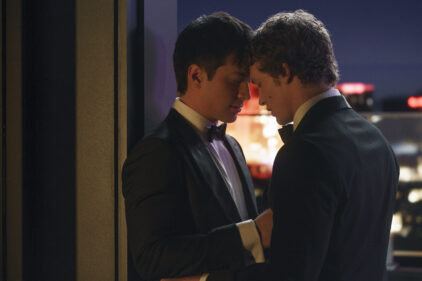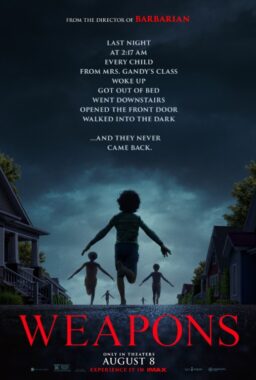Here’s one thing I learned while working my way through “Stanley
Kubrick: The Masterpiece Collection”—there may be no director more
difficult to casually watch. Having seen all eight of the films in the new
Blu-ray set—“Lolita,” “Dr. Strangelove,” “2001: A Space Odyssey,” “A Clockwork
Orange,” “Barry Lyndon,” “The Shining,” “Full Metal Jacket,” “Eyes Wide Shut”—more
than once, I presumed I could sort of use them as background viewing while I
worked on other things. Silly me. Kubrick films draw you in; they defy casual
viewing for serious film fans. Every carefully considered shot in “2001”; every
turn of phrase in “Eyes Wide Shut”; every hidden message in “The Shining”
(kidding, don’t write me about the moon landing)—they are all foreground, not
background. Don’t make the same mistake I did. Give this set your complete
attention.
Warner Bros. and Stanley Kubrick always had a close
relationship, and so Christiane Kubrick allowed the company exclusive access to
a lot of his personal, archival material to produce a new, exclusive
documentary for this set called “Kubrick Remembered.” It joins two,
new-to-Blu-ray documentaries—“Stanley Kubrick in Focus” and “Once Upon a Time…’A
Clockwork Orange’—and additional documentaries “Stanley Kubrick: A Life in
Pictures” and “O’ Lucky Malcolm!,” which were issued as a part of WB’s last
holiday season wave of Kubrick Blu-rays. Yes, it is undeniable that WB has been
here before, although the new material is interesting, the packaging is the
best to date, and the physical materials, including a new 78-page hardcover book,
will be enticing to fans of the late, great director. This is one of those
releases which can be difficult to recommend if you already own the eight films
contained within it. However, if you don’t own them yet, it’s now the best way
to correct that grievous cinematic oversight.

As these sets often do, it starts with 1962’s “Lolita”—for the record, earlier films such as “The
Killing” and “Paths of Glory” are available in Criterion Blu-ray editions that
are must-owns while “Spartacus” is also available in a lavish standalone
release. Kubrick’s adaptation of the timeless Vladimir Nabokov novel stands as one of
the best, even fifty years later, and despite the severe restrictions placed on
the production by the Hays Code. Kubrick was reportedly disappointed by the
final product because of the censorship required to get it made, but I’ve
always found his approach to “Lolita” fascinating partially because of how he
had to “talk around” the issues that the Catholic Legion of Decency found so
offensive. It creates a film that almost feels more like a dream state than the
literal approach that complete freedom of subject matter may have allowed. And
it emphasizes some of the dark comedy aspects of the film. Some of the discs in
this set include phenomenal special features—this is not one of them. All that
found its lonely way to the “Lolita” disc is the theatrical trailer. Boo. The
film itself looks good but no better than previous releases. In fact, you can
consider that the assessment of every film in the set—their transfers are solid
but comparing HD quality on standalone releases for films like “2001” and “The
Shining,” I could discern no notable improvement or decline, adding to the
sense that if you already own the films, this set may be a tough upgrade.

Two years after “Lolita” came one of Kubrick’s most
rewatchable films, “Dr. Strangelove or:
How I Learned to Stop Worrying and Love the Bomb,” a black comedy that
feels nearly as current to the state of international politics today as it did
five decades ago. With phenomenal performances by Peter Sellers and George C.
Scott, among others, “Dr. Strangelove” was a film that really changed the
cinematic comedy language. Kubrick’s film was both hysterical and terrifying,
often in the same beat. Comedy didn’t have to be slapstick; it could comment on
serious issues through the humor, often connecting more than its dramatic
counterparts. The disc for this film makes up for “Lolita,” offering numerous
special features, including an interesting piece called “The Art of Stanley
Kubrick: From Short Films to Strangelove,” and, believe it or not, an interview
with Robert McNamara of all people. May all satirical targets one day do an
interview about their satire. I long for the Dick Cheney interview on the
anniversary edition of “W.”

The hits keep coming with “2001: A Space Odyssey,” a regular entry on lists of the best films
ever made. If you ever get the chance to see a 70MM presentation of Kubrick’s
most influential film, take it. Even if it’s hundreds of miles away. Get there.
What more could I possibly say here about “2001,” a film that thousands of
people have dissected in classes, at presentations, in books, etc.? Perhaps that’s
something to consider—has any film been as completely broken apart, analyzed,
and considered as “2001”? Sure, some of the Hitch classics, “The Godfather,”
etc. are in the conversation, but “2001” has a special pedestal in the history
of film museum. It defined so many things about the era of filmmaking that it
was going to usher in in the ‘70s—auteur-driven, unapologetic, completely
unconcerned with the mainstream, pieces of art. “2001” is one of those films
that grows richer as I age—a work that I see new things in every time I watch
it. When you’re young, “2001” is about something different than it is as you
age. As a kid, it was the technology of it all that amazed me—a cousin of my
favorite movie, “Star Wars.” Now, I appreciate so many of the visual choices
and daring storytelling turns Kubrick was willing to take. “2001” speaks to
what I love about cinema in that no other filmmaker would have adapted Clarke’s
story exactly the same way. It is Kubrick’s film as much as it is Clarke’s. The
special features on “2001” are extensive, given that they’re ports of previous Special
Edition releases, including “2001: The Making of a Myth” hosted by James
Cameron, “Standing on the Shoulders of Kubrick: The Legacy of 2001,” a 1966
interview with Kubrick, a commentary by Keir Dullea and Gary Lockwood, and much
more.

1971 saw the release of Kubrick’s most divisive
and controversial film, “A Clockwork
Orange,” a film I’ve had an up-and-down relationship with over my years as
a film critic. As a teenager amazed that a major, Oscar-nominated filmmaker had
even produced something this aggressive, powerful, and dynamic, I was blown
away. As I’ve aged, it’s slid down a bit on my list of Kubrick faves. Maybe it doesn’t hold up quite like his other films—having its greatest impact
the first time you see it. Maybe I’m just getting soft as I get older. Whatever
you think of Kubrick’s adaptation of the Anthony Burgess novel, it is an
important film, a work that’s still referenced and still influencing the form.
Again, this film has been released by WB individually numerous times, and so it
comes loaded with special features, including a commentary by Malcolm McDowell
and historian Nick Redman, and special features like “Still Tickin’: The Return
of Clockwork Orange” and “Great Bolshy Yarblockos! Making A Clockwork Orange.”

If “A Clockwork Orange” has slid the most in my estimation
as I’ve grown older, “Barry Lyndon”
has gone in the other direction. When you’re a teenager falling in love with
movies and blasted through the back of your living room by “Clockwork Orange,” “The
Shining,” and “Full Metal Jacket,” there’s nothing less interesting than the
candle-lit period drama of the Seven Years War. I still find the film a bit too
fussy and stuffy at times for its own good, but, again, the deliberate
cinematic choices that I couldn’t appreciate when I was younger look more
remarkable now. The coldness that would often be used as the biggest criticism
against Kubrick’s work (and led to this film falling relatively flat at the box
office and with critics on release) feels like careful consideration now more
than emotional detachment. We observe the saga of Barry Lyndon instead of being
asked to fill his shoes or even empathize with it. That’s a remarkable
achievement in and of itself. It’s also one of Kubrick’s most technically
accomplished films, a fact one realizes more completely on Blu-ray. I don’t
want to blame VHS for my initial lack of appreciation, but it didn’t help. Sadly,
WB has yet to re-appreciate the work as the only special feature on the disc is
the theatrical trailer.

From the detailed costume drama of “Barry Lyndon” to the
outright insanity of “The Shining,” the
6th film in this 8-film set. Again, what more could I possibly write
about one of the most dissected horror films of all time? Personally, I love “The
Shining,” more with each subsequent viewing. It is one of cinema’s most
remarkable blends of physical and mental horror. What I mean by that is that we
often see physical threats—the ghosts of “Paranormal Activity,” the killers of
slasher films like “Friday the 13th,” the game players of movies
like “Saw”—but it’s rare that a filmmaker can blend the actual threat of
violence with the psychological underpinnings of isolation and familial
betrayal like “The Shining.” It is a film that recognizes that ghost stories
are much more terrifying when they speak to relatable issues like the wrath of
an angry father. And it is technically phenomenal on every level. I love “The
Shining.” Given that I’m far from alone in that love, the special features here
are extensive, including “View from the Overlook: Crafting The Shining,” “The
Visions of Stanley Kubrick” and “The Making of The Shining,” which includes
footage of Kubrick directing the film.

If “A Clockwork Orange” is Kubrick’s most divisive films, “Full Metal Jacket” is very close
behind. It’s always been a work that frustrates me, largely due to its two-film
structure. The first half of the film, the definitive cinematic look at
boot-camp hell, still resonates, but I often found the second half of the film
derivative to a fault. Yes, I understand the argument that it’s supposed to be—that
Kubrick is commenting on cinematic examinations of war as much as he is war
itself—and yet the final hour of “Full Metal Jacket” still frustrates me more
than anything else in this set. There’s some stunning filmmaking here, but the emotional
detachment argument against Kubrick resonates most strongly here for me. Special
features here are more scant but the commentary by Adam Baldwin, Vincent D’Onofrio,
R. Lee Ermey, and Jay Cocks is great.

Which brings us to the end of Kubrick’s career and one of the most underrated films of the
last quarter-century, the masterful “Eyes
Wide Shut,” a film that still hasn’t gotten the reappraisal it deserves.
Watching it again in this set, I felt its power even more resonantly, and got
angry all over again for its dismissal in 1999. Sure, some critics understood
its power, but too many people got caught up in the ratings controversy and the
casting drama of Tom Cruise and Nicole Kidman to really see what Kubrick was
doing here—creating one of the most memorable dramas about the insecurity of
the modern male that’s ever been made. It is, at its core, a film about a man
whose life unravels after he learns that his wife is a sexual being in ways he
can’t control. It is about how lack of control can be the most life-changing
thing possible. And it is technologically breathtaking. From the very beginning.
In fact, this is the one that distracted me the most as I tried to use Kubrick
as background material. That’s a mistake I won’t make again.












